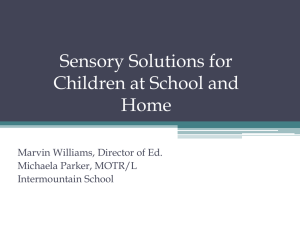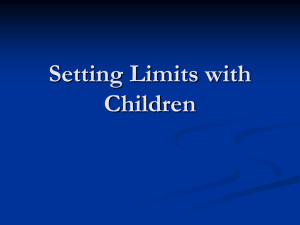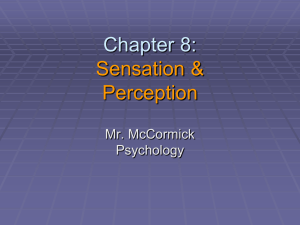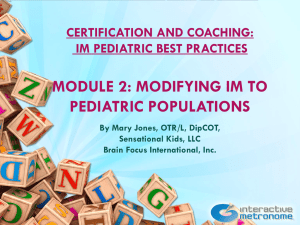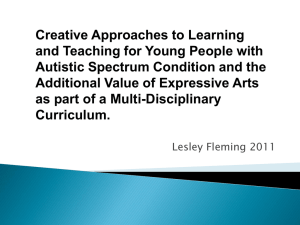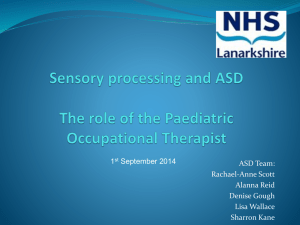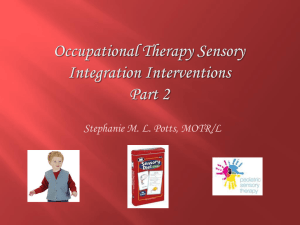Sensory Processing
advertisement
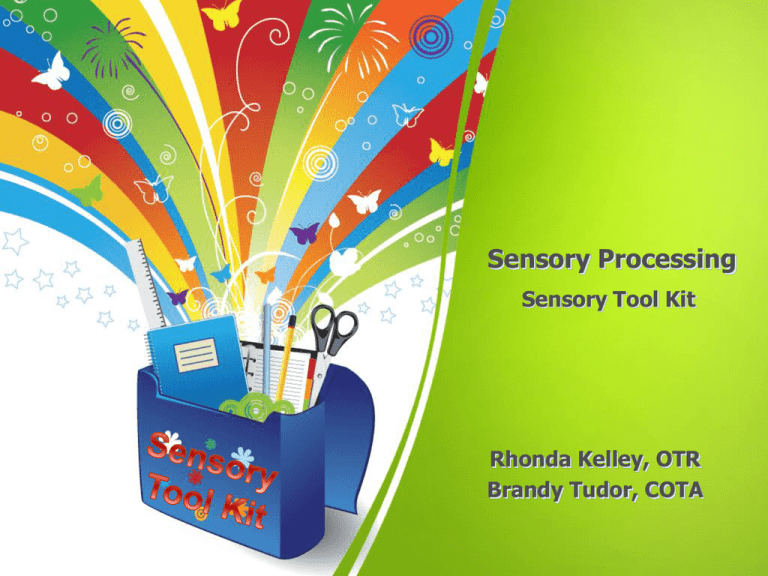
Sensory Processing Sensory Tool Kit Rhonda Kelley, OTR Brandy Tudor, COTA What is Sensory Processing? • Sensory processing refers to how the brain takes in information from the sensory systems • The brain registers, interprets and uses this information to – Screen or ignore the sensory stimuli – Notice it and respond to the stimuli – Habituate the stimuli • We need sensory input for our brain to develop and continue to function properly Sensory Systems • Tactile (touch) • Vestibular (balance & movement) • Proprioception (body awareness; muscles and joints) • Visual (sight) • Auditory (hearing) • Gustatory (taste) • Olfactory (smell) What is Sensory Regulation? • Regulation allows us to focus on what is important • A well regulated student is able to notice relevant stimuli and filter out unimportant stimuli • Emotions and behavior reflect appropriate responses to the situation rather than to the environment • Regulation Disorder – The brain has difficulty with determining what is important. It is difficult to organize the environmental stimuli. Sensory Processing Deficits: • Limit one’s productivity • Limit one’s enjoyment and participation • May result in poor self-esteem • Cause avoidance behaviors • Cause unexplained outbursts • Decreases social skills & participation in play • Cause difficulty with life skills at home & school • Anxiety • Poor attention • Poor regulation of reactions to others • Poor motor skills development Types of Sensory Processing Difficulties Just Right Sensory Strategies Sensory Strategies • Implement a Sensory Diet • Use proprioceptive input – “magic pill” for sensory regulation – – – – Heavy work stimulates the brain to bring arousal to a normal level Heavy resistance against muscles invokes a quick calm and increases body awareness to help the student feel more grounded Helps the student feel “just right” Effects can last from 90 minutes to 2 hours • Use vestibular input – can have alerting or calming effects depending on the type of movement involved – – – Fast movement – alerting Slow, rhythmical movement – calming Avoid spinning • Use pressure touch – can have a calming effect – – Soothing – slow, continuous, steady, prolonged Exciting – fast, intermittent, vibratory • Use deep pressure – – Inhibits tactile defensiveness (over responsiveness) Can produce a calming effect • A planned, scheduled activity program to specifically meet the needs of the student’s nervous system • The purpose is to bring them to a “just right state” to be ready for learning • The schedule is individualized to the student’s school schedule • Need at least 10 minutes of moderate activity to increase serotonin and the effect could last up to 2 hours • Not a cure all for behavior but you can meet the sensory needs while addressing the behavior • Walking, running, jumping, rolling • Doing chair or wall push-ups • Erasing boards • Chewing/crunching/sucking • Crawling (tunnels/obstacles) • Jumping on trampoline • Stacking chairs • Wearing a weighted vest* • Wearing a weighted backpack • Carrying crate with books Weighted Vest *Only use weight up to 10% of child’s body weight. Child only wears the vest for 20-40 minutes. Student Scenarios • Difficulty with sitting still during carpet time • Continually making noises • Avoids certain centers • Chews on coat and other things • Difficulty in music class • Does well on the playground • Sitting still during carpet time – Choose 1-2 heavy work activities before going to carpet time – Use weighted item in lap or on shoulders – Sit on shag carpet square or disco sit – Alternative seating (bean bag, cube chair, rocker) • Continually makes noises / chews on items – Blow bubbles, kazoo, harmonica before carpet time – Chew on candy (Starbursts, gummy bear) – Drink through a straw / water bottle – Sing silly songs with mouth movements • Avoids certain centers – Heavy work activity before going to non-preferred center – Count down with timer – Cue to start / cue to stop (warning) – Use a transition item (sticker) • Difficulty in music class – Change placement in class; sit by friend – Cue to start / cue to stop / transition item – Wear headphones (if bothered by loud noise) • Does well on the playground – Do not use playground as a punishment – Observe him to see what he is seeking and use it during the day • Transition Activities – Notify in advance / visual schedule – Push or carry heavy object to new activity – Skip, hop, dance – Compression on shoulders – Use a clapping or rhythmic beating to signify change – Sing a song • Sleepy during the day • Inattention / difficulty sustaining attention • Easily frustrated • Sleepy during the day – Alerting activities (jumping, walking, chair pushups) – Wash hands – Chew on candy or chewy tube • Inattention / difficulty sustaining attention – Bring attention to task (bright colors; highlight edge of paper; add stickers) – Fast rhythmic music – Break large tasks into smaller steps – Heavy work activity before starting task • Easily frustrated – Heavy pressure / shoulder compression to calm down – Complete tasks in small steps – Clear beginning and an end to task – Continue with puzzle piece strategy Resources http://dsaundersot.webs.com/The%20Import ance%20of%20Sensory%20Processing.pdf




